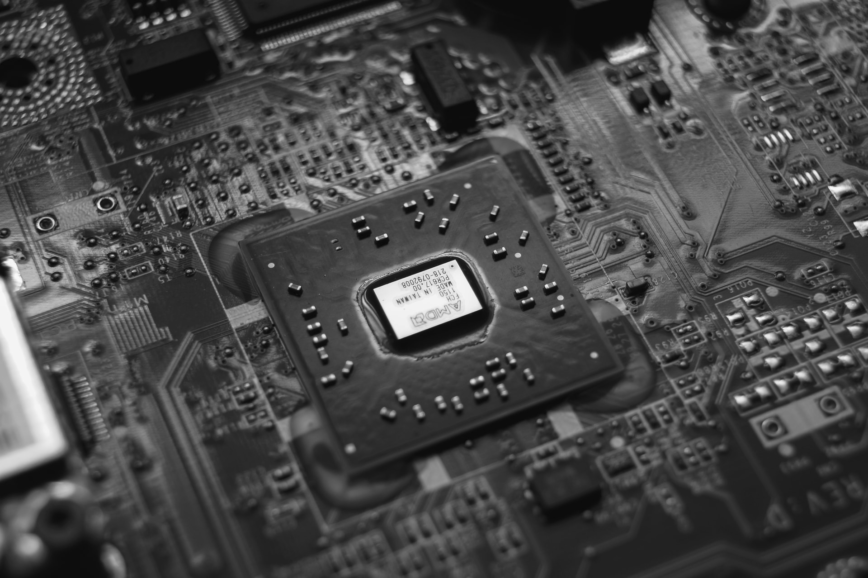The semiconductor value chain is highly interdependent, with some areas overwhelmingly dominated by a few companies or countries. Given Europe’s position in the value chain, European policymakers working toward strategic autonomy would do well to consider questions of access, leverage and resilience in addition to ownership.
Semiconductors, such as processors or memory chips, are the drivers of the accelerating digitalization of our industry and society. Artificial intelligence, 5G and other emerging technologies that receive a lot of attention from policymakers all rely on high performance, leading-edge chips. However, Europe has played only a minor role in the semiconductor value chain: for the past three decades, the European semiconductor industry had a world market share of between just 8 and 13 percent. Thus, Europe’s aspirations of playing a meaningful role when it comes to any of the abovementioned emerging technologies depend on continued access to chips from foreign countries such as the United States, South Korea and Taiwan. Furthermore, semiconductors are at the heart of the intensifying US-China technology rivalry, with direct implications for European companies. That is why Europe needs to strategically assess its position within the semiconductor value chain and its dependencies on foreign technologies, and consider whether these negatively impact Europe’s goal of technological sovereignty in that area.
Tracking the Global Semiconductor Value Chain
The global semiconductor value chain is highly interdependent and concentrated and relies on strong divisions of labour in pursuit of economic efficiency and pressure to innovate. Production of each of the different types of leading-edge semiconductors is dominated just by a handful of companies. Essentially any personal computer, from laptops and desktops to servers, uses x86 processors from either Intel (82% market share) or AMD (18% market share) – both are US companies. DRAM chips, quintessential “short-term” memory for all computing devices, are produced by either Samsung and SK Hynix in South Korea or Micron in the US – the three companies have a combined market share of 95%. Mobile processors in smartphones or tablets are based on design and IP from one company – ARM Holdings, headquartered in the UK but owned by SoftBank in Japan and possibly soon to be bought by Nvidia in the US.
In addition to particular semiconductor technologies, the value chain itself is highly concentrated. The production of semiconductors consists of three relatively distinct steps: chip design, fabrication and assembly & test. Companies from the United States, Taiwan, South Korea and Japan are the key actors within that value chain.
Companies that design chips and rely on contract chip makers for fabrication and assembly are called “fabless” – they lack a “fabrication plant”. Home to companies such as Broadcom, Qualcomm, Nvidia and AMD, the United States is leading, by far, in this $110 billion industry. The semiconductor industry in general is highly R&D intensive and fabless companies easily spend upwards of 20% of their revenue on R&D. Taiwan is a distant number two in the fabless world with companies such as MediaTek and Realtek. Interestingly, with the advent of machine learning and the need for application specific integrated circuits (ASIC), new players are entering the market: Amazon, Google, Tesla, Baidu, Alibaba and many others are all developing their own chip designs these days.
Although an increasing number of fabless companies are designing chips, the necessary design software – Electronic Design Automation (EDA) tools – essentially comes from three US-based companies: Cadence Design Systems, Synopsys and Mentor Graphics (acquired in 2017 by Siemens). Without access to these US-origin EDA tools, it is impossible to develop modern chips, which is why US export control measures are so effective. Even though HiSilicon, a 100 percent-owned subsidiary of Huawei, has become the largest Chinese fabless company, the company still relies on these US-origin EDA tools. The recent US export control measure specifically cuts HiSilicon’s access to these US-origin chip design tools, making it essentially impossible for the Chinese fabless company to design leading-edge chips.
Fabless companies send their designs to contract chip makers, so called pure-play foundries, to fabricate their chips. The Taiwanese Semiconductor Manufacturing Company (TSMC) is, by far, the largest contract chip maker in the world, with a market share of around 55%. At the time of writing, it is also one of only two foundries able to produce cutting-edge 5nm chips, closely followed by Samsung in South Korea, which in 2019 announced plans to invest $108 billion in its contract foundry business through 2030.
Fabrication plants or “fabs” use semiconductor manufacturing equipment (SME) and chemicals to transfer customer chip designs onto silicon wafers. Over time fabs and their equipment have become increasingly complex to keep pace with the demand for ever-smaller and more-powerful chips. Setting up a modern fab today costs upwards of $15 billion, which is why there are just two contract chip makers available to produce designs below 10nm: TSMC in Taiwan and Samsung in South Korea. The Semiconductor Manufacturing International Corporation (SMIC), the largest Chinese pure-play foundry, is lagging three to four years behind TSMC and Samsung and has also been subject to US export control restrictions since September 2020.
The high costs of setting up a foundry stem partly from the increasingly complex and expensive manufacturing equipment (SME) necessary. The SME market is relatively concentrated and dominated by US (Applied Materials, Lam Research, KLA) and Japanese (Tokyo Electron, Advantest, Hitachi High-Tech) companies. One noteworthy exception is ASML, a Dutch company that has a monopoly on the Extreme Ultraviolet (EUV) photolithography equipment necessary for a key production step in a fab. To build these machines that sell for $120 million each and weigh 180 tons, ASML relies on a network of 5,000 suppliers and countless R&D collaborations. Without such an EUV scanner, fabs cannot produce chips smaller than 7nm and ASML is currently (and most likely will be for quite some time) the only company that sells them.
Because the SME market is relatively concentrated and US-origin technology plays a key role in certain production steps, the US government’s export control measures against Huawei specifically focused on manufacturing equipment: pure-play foundries such as TSMC, Samsung or even SMIC in China are not allowed to use US-origin equipment to manufacture chips for Huawei. Additionally, the US government urged the Dutch government to withhold an export license necessary for ASML to sell EUV equipment to SMIC. So far, the Dutch government has not renewed this export license and, at the time of writing, ASML is not allowed to sell EUV equipment to SMIC.
The last step from design to the finished chip is assembly & test. Outsourced Semiconductor Assembly & Test (OSAT) companies receive the developed silicon wafers from foundries and cut and test them to then assemble them in packages. Historically, OSAT has been labour-intensive, in contrast to the capital-intensive foundry business and skill-intensive fabless industry – roughly speaking. The $30 billion-plus OSAT market is split between Taiwanese, Chinese and US companies – with Taiwanese companies holding more than 50% market share. Just like foundries, OSAT companies depend on equipment vendors and chemicals suppliers – but to a much smaller degree.
In summary, the semiconductor value chain relies on strong divisions of labour – companies from the US, Taiwan, Japan, South Korea and Europe need to collaborate to produce leading-edge chips. No country is self-sufficient in that regard. The semiconductor value chain is, furthermore, highly concentrated in certain production steps and technologies. That’s why the semiconductor value chain is efficient but not resilient against external shocks, such as disruptive trade policies (export control measures) or conflicts.
Towards an Autonomous European Capacity?
So where is Europe in all of this? In terms of overall market share, Europe plays an almost minuscule role in the semiconductor value chain, with around 10% for the past three decades. Europe has almost no fabless companies and no home-grown foundry businesses. European semiconductor companies, such as Bosch, Infineon, NXP or STMicroelectronics, operate as Integrated Device Manufacturers (IDM): they take care of design, fabrication and assembly & test in-house. Not surprisingly, all four companies have a strong presence in automotive semiconductors, with Infineon and NXP leading this market. Europe has, furthermore, a certain presence in various supplier markets: silicon wafers from Siltronic and Soitec; manufacturing equipment from ASML and ASM International; chemicals from Linde and Merck. Of course, these examples do not even scratch the surface, but are simply meant to illustrate that Europe is highly interdependent with foreign companies throughout the semiconductor value chain.
The European Commission’s New Industrial Strategy for Europe addresses the importance of microelectronics (semiconductors) and the goal of “strategic autonomy”. Thierry Breton, European Commissioner for Internal Market, recently said that “strategic autonomy – is not about isolating ourselves. It is about Europe defending its strategic interests. … Without an autonomous European capacity on microelectronics, there will be no European digital sovereignty. … Now we must invest massively, with the objective to produce in Europe high performance processors (with a 2 to 3nm of feature size) and reach 20% of the world capacity in value”.
It is laudable that European policymakers realised that any endeavours in emerging technologies are based on leading-edge semiconductors, and that here Europe has been in the backseat for a long time. But how do “high performance processors” and “20% of the world capacity” empower Europe’s strategic autonomy? The semiconductor value chain will continue to be highly concentrated throughout certain production steps and technologies. And these choke points can (and will continue to) be weaponised by governments through well-executed export control measures for geopolitical purposes. The question thus remains, what exactly is “an autonomous European capacity on microelectronics” and is there even any likelihood that this can be achieved?
As an example, even the European Processor Initiative (EPI) to develop processor cores utilises the aforementioned ARM architecture (which, at the time of writing, is owned by Japan’s SoftBank, but which may soon be acquired by Nvidia in the US) and collaborates with TSMC to fabricate those chips in TSMC’s 6nm fabs in Taiwan. EPI needs access to foreign EDA software tools to design the chips and TSMC relies on European, US and Japanese equipment to fabricate EPI’s processors in Taiwan. Thus, these “European processors” are still produced within a global value chain, naturally.
This is not necessarily a bad situation. European strategic autonomy in semiconductors cannot mean that Europe follows the United States government’s reshoring efforts. The US approach to “bring back” leading-edge contract chip making to US soil might work for the US, because it has the largest fabless industry and thus could operate those fabs at full capacity. Europe’s IDMs, by and large, do not rely on leading-edge fabs and Europe lacks a strong fabless industry, so who would utilise leading-edge European fabs?
Of course, industrial policy will play an important part in Europe’s ambition to play a stronger role within the semiconductor value chain. But just as important are trade and foreign policy designed to ensure that the European industries have continued access to foreign technologies. Ursula von der Leyen is right in asserting that “first, we must have mastery and ownership of key technologies in Europe. These include … critical chip technologies”. But it is not (just) about ownership. Semiconductors are strategic assets developed and built by a global value chain. The challenge for EU policymakers is thus threefold: First, how to ensure and secure access to foreign technology providers through trade and foreign policy? Second, how to build leverage by strengthening domestic companies through strategic industrial policy? Third, how to foster and support a more resilient value chain?
In October 2020 the authors published a paper that provides an overview of and introduction to the global semiconductor value chain for policymakers.
Thumbnail image: Credits to Jorge Salvador on Unsplash




